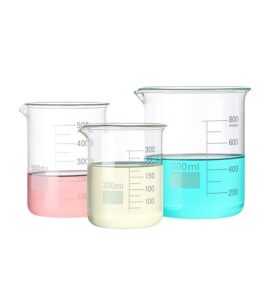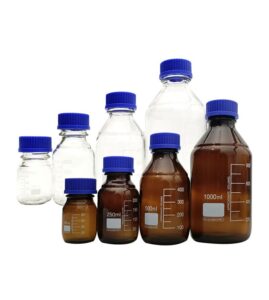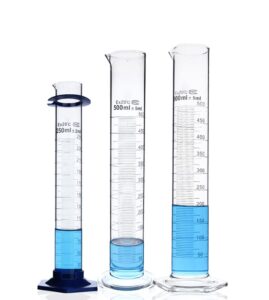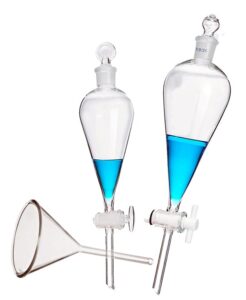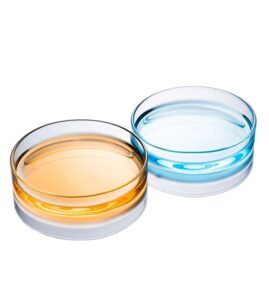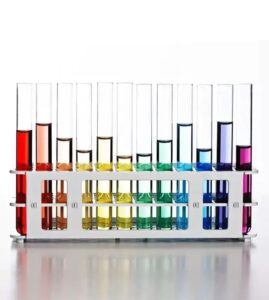In the realm of scientific research and experimentation, lab glassware holds an unparalleled significance. But have you ever wondered how the quality of these essential tools is determined? What makes one piece of glassware superior to another, and why does it matter?
Quality in lab glassware is not just about durability; it’s about precision, reliability, and safety. These are the pillars that support the integrity of scientific work. But how is this “mark of quality” established, and who sets these standards?
Understanding the nuances of lab glassware quality can enlighten both newcomers and seasoned professionals in the scientific community. Let’s delve deeper into the world of lab glassware and uncover the benchmarks that define excellence.
What Makes Lab Glassware “High Quality”?
The quality of lab glassware is determined by a variety of factors, from material composition to manufacturing processes. But at the heart of quality assessment are the standards and certifications that lab glassware must meet.
Materials like borosilicate glass are prized for their thermal and chemical resistance. The production process, including how the glass is annealed, can also impact its durability and performance. However, these characteristics only scratch the surface.
Standards and Certifications
Standards such as ISO 9001 for quality management systems and ASTM (American Society for Testing and Materials) specifications play a crucial role. These standards ensure that glassware is capable of withstanding the rigorous conditions of laboratory work.
For example, volumetric glassware often needs to meet specific calibration standards. This precision is critical for experiments where the accuracy of measurements can determine the success or failure of a project.
Navigating Quality Standards
For labs looking to ensure their glassware meets the highest standards, the first step is understanding the certifications and markings that denote quality. These can vary by region and type of glassware but generally include:
- ISO Certification: Indicates that the manufacturer meets international standards for quality management. This certification is widely recognized and respected across the globe, serving as a benchmark for quality assurance.
- ASTM Compliance: Shows adherence to specific American standards for laboratory equipment. The American Society for Testing and Materials sets rigorous standards for various materials and products, including lab glassware.
- CE Marking: Found in Europe, indicating that the product meets EU safety, health, and environmental requirements. The CE mark assures that the glassware complies with EU legislation and can be sold throughout the European Economic Area.
- JIS (Japanese Industrial Standards): This denotes compliance with Japan’s standards for industrial products and services. The JIS mark signifies that lab glassware meets the criteria set by the Japanese government for quality and safety, ensuring reliability and precision in laboratory settings within Japan.
- GB Standards (Guobiao Standards): These are the Chinese national standards, issued by the Standardization Administration of China. GB standards ensure that products, including lab glassware, meet the regulatory requirements in China for quality, safety, and environmental impact. The mark indicates that glassware is suitable for use in rigorous scientific research while adhering to China’s national standards.
Armed with this knowledge, lab managers can make informed decisions when procuring glassware, ensuring that their selections meet the necessary standards for their specific applications. Understanding these regional certifications and markings is crucial for labs operating in or sourcing materials from these areas, guaranteeing that their equipment upholds the highest levels of quality and safety.
Why Do These Standards Matter?
In a lab, accuracy and safety are paramount. Quality standards ensure that glassware will not only provide precise measurements but also resist breakage, which can lead to accidents or contamination.
Moreover, compliance with these standards is often required by regulatory bodies. This compliance ensures that research findings are credible and that experiments can be replicated accurately by others in the scientific community.
How Can You Identify High-Quality Lab Glassware?
Navigating the quest for high-quality lab glassware is essential for any laboratory’s success. In the following sections, we outline a comprehensive approach: starting with the foundational quality standards, moving through essential strategies for assessing glassware, and rounding off with additional techniques to ensure you select the best tools for your scientific endeavors. This structured exploration provides a clear path to identifying superior lab glassware.
Comprehensive Quality Standards for Laboratory Glassware
In the pursuit of excellence in scientific research, the quality standards for laboratory glassware play a pivotal role. These standards encompass several critical aspects to ensure that each piece of glassware can withstand the rigors of laboratory work while providing accuracy, durability, and safety. Here, we delve into the key areas that define the quality of laboratory glassware, seamlessly integrating these standards into the broader context of laboratory operations.
Material Standards
The choice of materials for laboratory glassware is foundational to its performance. Glassware must be crafted from materials that meet or exceed national and industry standards. These materials ensure the product’s strength, corrosion resistance, and durability, critical attributes for the demanding environment of a laboratory.
Dimensional Accuracy
Precision in the dimensions of laboratory glassware is essential. Adherence to national and industry standards for dimensions requires sophisticated manufacturing techniques. This precision ensures that measurements are accurate and reliable, a cornerstone of scientific experimentation.
Surface Quality
The surface of laboratory glassware should be smooth and flawless, without any bubbles, cracks, or imperfections. This level of finish not only affects the glassware’s aesthetic but also its functional integrity, especially in experiments where surface interactions could influence results.
Sealing Performance
Good sealing performance is non-negotiable for laboratory glassware, particularly for apparatus that store or measure liquids and gases. Effective seals prevent leaks and gas escapes, ensuring the safety and accuracy of experiments.
Thermal Resistance
Laboratory glassware must withstand the stresses of thermal changes without deforming or cracking. This resistance to both high and low temperatures is crucial for experiments involving temperature fluctuations.
Mechanical Strength
Given the potential for mechanical impacts and vibrations in a laboratory setting, glassware must possess sufficient mechanical strength. This includes resistance to compression, bending, and impact, safeguarding against accidental damage.
Safety Features
Safety is paramount in the use of laboratory glassware. Products must comply with safety standards to protect users and the environment from harm, including the safe handling and disposal of glassware.
In summary, the quality standards for laboratory glassware cover a broad spectrum of requirements, from material selection to safety considerations. Manufacturers must rigorously adhere to these standards, employing strict quality control measures to ensure their products meet the high expectations of the scientific community. This commitment to quality not only supports the integrity of scientific research but also underscores the responsibility of manufacturers to provide safe, reliable, and precise tools for discovery.
The integration of these comprehensive quality standards is a testament to the scientific community’s dedication to excellence. As we continue to explore the frontiers of science, the reliability and integrity of our tools remain as crucial as the curiosity that drives us forward.
Core Strategies for Assessing Lab Glassware Quality
- Look for marks of certification: Quality glassware will often have etchings or labels indicating compliance with certain standards.
- Check the manufacturer’s reputation: Established companies with a history of quality products are more likely to produce reliable glassware.
- Consider the glassware’s specifications: Ensure they meet the needs of your specific experiments or processes.
Identifying High-Quality Lab Glassware: Additional Methods
In addition to the aforementioned strategies for discerning the quality of lab glassware, there are other practical methods that can further aid in making informed decisions. These approaches complement the initial steps and ensure a comprehensive assessment of glassware quality.
Evaluate Transparency and Uniformity
High-quality lab glassware should exhibit a clear and consistent transparency, free from any coloration or distortion, which could indicate impurities or flaws in the glass. Uniformity in thickness is also crucial, as it can affect the glassware’s resilience and thermal resistance. By closely inspecting these physical attributes, researchers can gauge the overall quality and suitability of the glassware for precise experiments.
Inspect for Stress Patterns
Utilizing polarized light can reveal stress patterns within the glass that are not visible to the naked eye. Stress patterns may indicate uneven cooling or manufacturing defects that could compromise the glassware’s structural integrity and performance under varying temperatures. This inspection is particularly important for glassware that will be subjected to thermal stress in applications such as autoclaving or heating.
Review Performance Under Actual Lab Conditions
If possible, evaluating the glassware’s performance under actual laboratory conditions can provide invaluable insights into its quality. This could involve testing the glassware’s chemical resistance, thermal stability, and durability during typical use cases. Feedback from lab personnel who regularly use the glassware can also highlight issues or advantages that might not be immediately apparent from physical inspections or manufacturer specifications.
Consult Peer Reviews and Recommendations
Finally, consulting peer reviews and seeking recommendations from fellow scientists can be incredibly beneficial. Colleagues who have firsthand experience with specific brands or types of glassware can offer practical advice and insights based on their own usage. Professional forums and scientific communities are excellent resources for gathering such information, helping to make well-informed decisions based on collective experiences.
By integrating these additional methods with the initial steps, researchers can thoroughly evaluate the quality of lab glassware. This holistic approach ensures the selection of glassware that not only meets rigorous standards but also stands up to the demands of cutting-edge scientific research.
The Importance of Maintenance
Maintaining the quality of lab glassware is just as important as selecting the right pieces. Proper cleaning, storage, and handling are essential to preserve the glassware’s integrity over time.
Routine inspections for chips or cracks can prevent accidents and ensure that the glassware remains in compliance with quality standards. Regular calibration is also crucial for volumetric instruments to maintain their accuracy.
The Impact on Scientific Research
High-quality lab glassware doesn’t just influence the outcome of individual experiments; it impacts the entire scientific research ecosystem. Reliable results depend on the precision that only quality glassware can provide. This precision is vital for peer-reviewed publications, where reproducibility of results is paramount. Without adherence to quality standards, the trustworthiness of scientific research could be compromised.
The Role of Glassware in Education
In educational settings, from high schools to universities, the quality of lab glassware serves as a silent instructor on the importance of precision and reliability in science. Students learning with high-quality equipment are not only safer but also gain a deeper understanding of scientific principles. They learn to appreciate the role of accuracy in experimentation and the critical nature of quality in scientific discovery.
The Economic Perspective
Investing in high-quality lab glassware might seem costly upfront, but the long-term benefits significantly outweigh the initial expenses. Durable, reliable glassware reduces the need for frequent replacements, saving money over time. Moreover, the accuracy it provides minimizes errors in experiments, which can be costly and time-consuming to correct. Thus, quality glassware is not just an operational expense but a wise investment in the efficiency and reliability of scientific work.
Sustainability Considerations
The conversation around lab glassware quality also touches upon sustainability. High-quality, durable glassware reduces waste, as it doesn’t need to be replaced as often as lower-quality alternatives. Moreover, companies that adhere to quality standards often follow environmentally responsible manufacturing processes. By choosing these products, labs contribute to a culture of sustainability within the scientific community.
Managing the Lifecycle of Laboratory Glassware
An often overlooked yet critical aspect of maintaining laboratory excellence is understanding the lifecycle of lab glassware. This encompasses not only the usage and maintenance but also the appropriate timing and methods for the disposal and recycling of used glassware. Integrating this knowledge ensures the sustainability of laboratory practices and aligns with environmental stewardship.
Recognizing the End of Usability
The decision to retire lab glassware typically comes when it no longer meets the quality standards necessary for precise scientific work. This could be due to visible wear and tear, such as scratches or chips, or more subtle signs like stress fractures or chemical etching that compromise safety and accuracy. Regular inspections are vital in identifying these signs early, preventing potential hazards or compromised results.
Disposal and Recycling Procedures
Proper disposal of lab glassware requires adherence to both safety protocols and environmental considerations. Non-contaminated glassware can often be recycled, contributing to the reduction of waste and support of sustainable practices. However, glassware that has been in contact with hazardous substances needs special handling. It should be decontaminated according to lab safety guidelines before disposal or recycling. Local regulations may provide specific instructions for disposing of hazardous materials and should always be followed to ensure environmental and personal safety.
In cases where recycling options are available, separating lab glassware from other types of glass and materials is essential due to its specialized composition. Specialized recycling facilities can handle lab glassware, transforming it into new products and furthering the cycle of sustainability.
Incorporating the management of lab glassware’s lifecycle into daily laboratory operations not only emphasizes the commitment to quality and safety but also reflects a broader responsibility towards environmental conservation. By doing so, labs can play a crucial role in advancing scientific research while fostering a sustainable future.
This holistic approach to lab glassware—from selection through to its end of life—underscores the comprehensive commitment required to uphold the highest standards of scientific integrity and environmental responsibility. As we navigate the complexities of modern research, let us remain vigilant in our pursuit of excellence, mindful of our impact, and dedicated to the principles of sustainability that guide responsible scientific exploration.
The Future of Lab Glassware Quality
As technology advances, so too do the standards and expectations for lab glassware quality. Manufacturers are continually innovating, creating materials that are more resistant to thermal shock and chemical corrosion, and designs that enhance the accuracy and usability of glassware.
Furthermore, digital integration is becoming increasingly prevalent, with smart lab equipment capable of automatically recording measurements and integrating with laboratory information management systems (LIMS). This evolution in lab technology underscores the ongoing importance of quality and precision in scientific research.
Conclusion
Embarking on the journey toward scientific excellence begins with choosing the right tools. Let this article be your guide in selecting high-quality lab glassware, the cornerstone of precision, safety, and reliability in your research endeavors. Embrace the standards, demand excellence, and contribute to a future where science advances with integrity and responsibility. Step into the lab with confidence, knowing your glassware meets the mark of quality that your work deserves.
FAQ: Understanding Quality Standards in Laboratory Glassware
Q1: Why are quality standards important for laboratory glassware?
Quality standards ensure laboratory glassware meets essential criteria for precision, durability, and safety. They guarantee that glassware can withstand the rigors of scientific experiments, providing accurate measurements and maintaining the integrity of research results.
Q2: What are some common certifications to look for when assessing the quality of lab glassware?
Key certifications include ISO Certification for quality management, ASTM Compliance for adherence to American testing standards, CE Marking for European safety and health requirements, JIS for Japanese industrial standards, and GB Standards for Chinese national standards. These certifications are markers of quality assurance and regulatory compliance.
Q3: How can you identify high-quality lab glassware?
High-quality lab glassware can be identified by certification marks, manufacturer reputation, and the glassware’s specifications. Additionally, evaluating transparency, uniformity, and performance under lab conditions can provide insights into the glassware’s quality.
Q4: When should laboratory glassware be retired and recycled?
Laboratory glassware should be retired when it shows signs of wear and tear, such as scratches, chips, or stress fractures, which could compromise safety and accuracy. Non-contaminated glassware can often be recycled, while glassware that has been in contact with hazardous substances requires decontamination before disposal.
Q5: How does managing the lifecycle of lab glassware contribute to sustainability?
Properly managing the lifecycle of lab glassware, from careful use and maintenance to responsible disposal and recycling, minimizes environmental impact. It supports sustainability by reducing waste and encouraging the recycling of materials, aligning laboratory practices with environmental stewardship.


